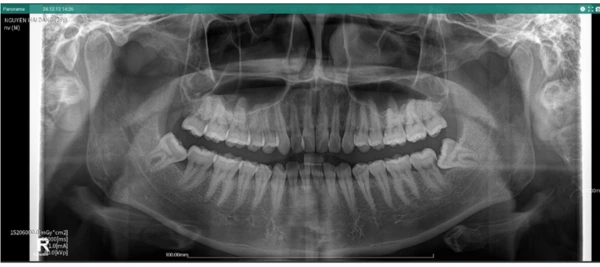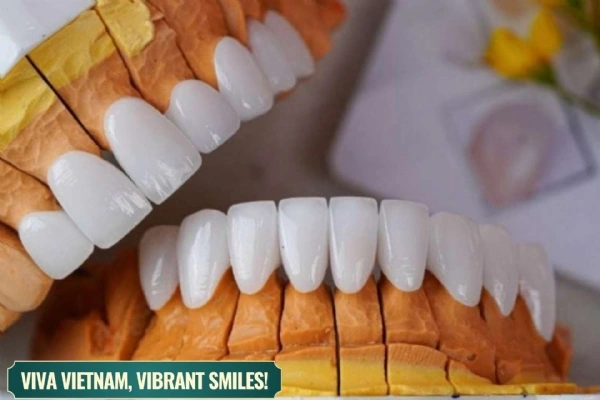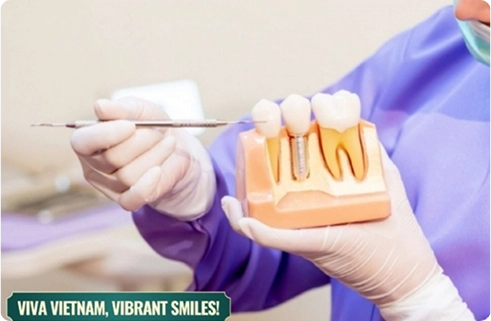Delaying wisdom tooth extraction for 4 years: Unforeseeable consequences and lessons learned from a clinical case
Wisdom teeth, the last teeth to erupt in the mouth, are often seen as the source of many oral health issues. However, many people still choose to delay addressing them, leading to unfortunate consequences. The story of Mr. N.H.Đ, a patient at Herident, is a clear example of the hidden dangers when wisdom teeth are not extracted at the right time.
The story of our patient who delayed wisdom tooth extraction for 4 years highlights the significant risks and consequences of postponing necessary dental procedures. Although he was aware of his dental condition, he had postponed treatment for a long time.
Initial diagnosis:
Through the examination and X-ray, the doctor diagnosed that he was facing serious issues due to delaying the extraction of his wisdom teeth. Specifically:
- Teeth 38 and 48 erupted incorrectly, causing complications.
- Teeth 18 and 28 erupted tilted towards the cheek.
Contents
The examination and treatment process at Herident
The wisdom tooth extraction is carried out according to a standard procedure to ensure the safety and optimal effectiveness for the patient.
1. Examination and consultation
First, a clinical examination is performed: A general assessment of the patient’s oral health and the position of the wisdom teeth. It was observed that the patient had four wisdom teeth, with R38 and R48 being positioned closely, while R18 and R28 did not have contact with the lower teeth, causing them to elongate, leading to food trapping and difficulty in cleaning.
Then, the patient underwent an X-ray to accurately determine the eruption direction, the condition of the jawbone, and the extent of the impact of the wisdom teeth.

The patient’s wisdom teeth are clearly visible in the panorama X-ray image.
On the panorama X-ray, R38 and R48 are seen to be very close to the nerve canal. However, this is a 2D image, and the boundary of the nerve canal is still clear. To ensure safety during the tooth extraction process, the doctor recommended that the patient undergo a CBCT scan to clearly observe the relationship between the wisdom tooth roots and the inferior alveolar nerve

On the CBCT scan, it was observed that R38 has two curved roots, not close to the nerve canal, and is tilted at an angle of about 70 degrees, pointing towards R37, causing decay at the cervical part of R37, close to the pulp

On the CT scan, it was observed that tooth R48 is tilted at an angle of approximately 47.78 degrees, with two hook-shaped curved roots. It is in close proximity to the lower nerve canal and has caused bone resorption near the distal side of R47.
2.Preparation before extraction:
- The patient underwent a professional dental cleaning (scaling) and was given instructions on proper oral hygiene before the extraction procedure.
- The patient will then undergo a checklist prior to the procedure, including reviewing allergy history and checking vital signs (pulse, blood pressure, etc.).
- Once ready, the wisdom tooth extraction procedure will proceed.
3. Proceed with the wisdom tooth extraction.
In this case, the doctor used ultrasonic waves to cut the ligament around the tooth, reducing trauma and helping the patient experience less swelling and pain after the procedure. The tooth was tilted nearly 60 degrees and had a point of contact with tooth number 7. Therefore, the doctor’s plan was to split the tooth’s crown and root, release the trapped point, and minimize bone exposure to preserve the bone as much as possible. The piezotome was used during this phase to remove the curved root close to the nerve canal without causing trauma, ensuring absolute safety for the patient.
The tooth extraction went smoothly, and the entire procedure took 30 minutes. The patient was very comfortable throughout the extraction process.
4.Suturing and Hemostasis
- After the tooth extraction, the doctor will stitch the wound to promote faster healing, prevent bleeding, and avoid infection.
- The patient will be asked to bite down on a gauze for 30-60 minutes to control the bleeding.
5.Post-extraction instructions:
- The doctor prescribes painkillers, anti-inflammatory medication, and antibiotics.
- The doctor provides instructions on oral hygiene, diet, and precautions to avoid complications such as infections.
- The doctor schedules a follow-up appointment in 3 days to check the wound and monitor the healing process.
- Treatment result: After 3 days, the patient returns for a follow-up appointment. Upon examination, the doctor finds that the patient has recovered very well, with no swelling or pain, and is able to eat and carry out normal activities as usual.
In-depth Analysis of the Consequences of Delaying Wisdom Tooth Extraction
Signs That Indicate Wisdom Teeth Need to Be Extracted
- Recurrent PainPain in the posterior jaw, specifically around the wisdom teeth, along with limited mouth opening, may occur. This condition might improve after a few days or lead to pus formation, often recurring multiple times. If left untreated, it can result in further complications, such as throat infections or digestive issues, as the pus from the infected area may be swallowed regularly. If these symptoms persist or keep recurring, it’s crucial to consider wisdom tooth extraction to prevent the development of more severe conditions.
- Gum Swelling or InfectionThe gum area around the wisdom tooth becomes swollen, red, inflamed, with pus or pain when touched, often occurring when the wisdom tooth is emerging. This is more commonly seen when the wisdom tooth is growing straight into the gum flap.
- Difficulty opening the mouth.If you experience difficulty opening your mouth or stiffness in the jaw, it could be a sign of a severe infection caused by the wisdom tooth, leading to jaw locking.
- Wisdom teeth that are decayed or have cavities can cause pain and discomfort, especially if the decay is left untreated. This can lead to further complications like infection, abscesses, or damage to nearby teeth.Due to their difficult-to-clean position, wisdom teeth are prone to cavities or can trap food, leading to decay in the adjacent teeth and causing more serious problems.
- Bad breath and a bitter taste in the mouth.These signs often occur when food particles or bacteria accumulate around the wisdom teeth.
- Wisdom teeth can cause pressure on adjacent teeth.If you feel pain or shifting in the teeth next to your wisdom tooth, or if they are even loose, it could be a sign that the wisdom tooth is growing tilted and may be causing bone resorption and pushing the adjacent tooth (usually tooth number 7) upwards.
The consequences of not extracting wisdom teeth in a timely manner
The benefits of early treatment:
Early treatment of wisdom teeth brings many benefits, not only helping you avoid uncomfortable pain but also protecting and maintaining your oral health effectively:
- Avoid serious complications.:Wisdom teeth that are misaligned or impacted, if not treated in time, can lead to infections, cavities, abscesses, and even damage to surrounding teeth. Early removal helps prevent these issues before they become serious or even life-threatening.
- Maintaining oral health:Timely treatment of wisdom teeth helps reduce pressure on the dental arch, preventing crowding and misalignment, and protecting the overall structure of your oral health.
- Save costs and time:Complications caused by wisdom teeth often require complex and costly treatments. Early intervention helps you avoid additional expenses and prolonged recovery time.
- Protecting overall health:Chronic oral infections can affect overall health, increasing the risk of conditions such as arthritis, cardiovascular diseases, or widespread infections.
- Quick recoveryExtracting wisdom teeth before complications arise is usually less complicated, helping you experience less pain and recover more quickly compared to handling the situation when it has become serious.
- Proactively addressing wisdom teeth not only helps protect your oral health but also ensures overall well-being, providing comfort and confidence in your daily life.
Failing to remove wisdom teeth can lead to many serious consequences.
Impacted or misaligned wisdom teeth.
- Wisdom teeth often don’t have enough space to erupt properly, leading to them growing sideways, horizontally, or remaining impacted beneath the gum.
- It causes the condition ofpersistent pain: Because wisdom teeth press against the gum tissue or adjacent teeth andSwollen and red gumsInflammation around the wisdom tooth area
- Impact on the adjacent tooth (tooth number 7): Causing pain, loosening, or decay of this tooth
- Decay teethWisdom teeth often emerge in hard-to-clean areas, making it easy for bacteria to accumulate and cause tooth decay
- Pericoronitis (inflammation around the crown of the wisdom tooth)
- Imperfectly erupted wisdom teeth often cause a condition called gum flap (gum covering the wisdom tooth)
- Signs:
- Pain and swelling.
- Difficulty opening the mouth and bad breath
- In severe cases, it can lead to an infection spreading to the surrounding area.
- If the wisdom teeth are not extracted, it can lead to pericoronitis (inflammation around the crown of the wisdom tooth)
Causing misalignment of the teeth on the dental arch.
- Wisdom teeth growing crowded or pushing other teeth, causing misalignment and affecting the bite.
- Causing difficulty in chewing or speaking.
- Cyst or jawbone resorption.
- Impacted wisdom teeth can form. A cyst around teeth.
- If left untreated, the cyst will:
- Destroy the surrounding bone tissue.
- Weaken the jaw structure, potentially leading to jawbone fracture.
- Impact overall health
- Wisdom tooth infection can spread, causing Sepsis,lymphadenitis or cellulitis of the jaw and face area
- Causing fever, fatigue, and more serious complications if not treated.
Warnings and advice from our experts
Regular dental check-ups not only help maintain oral health but also play a crucial role in early detection of issues related to wisdom teeth. Wisdom teeth, due to their difficult-to-reach location and tendency to grow crooked, are prone to complications such as infections, tooth decay, or negative impacts on adjacent teeth.
Through regular check-ups, dentists can monitor the eruption of wisdom teeth, take timely measures, and prevent potential issues before they become serious.
Don’t wait until the pain forces you to act – make regular check-ups an essential part of your healthcare routine
Removing wisdom teeth is not always necessary, but in many cases, it is the optimal solution recommended by the dentist to protect long-term oral health.
When the dentist determines that the wisdom tooth may cause complications, early removal will help prevent more serious issues. Therefore, always listen to professional advice and follow the doctor’s recommendations to ensure your oral health is best protected
Extracting wisdom teeth is a common concern, but you can significantly reduce stress by preparing properly. First, choose a reputable dental facility with modern equipment and strict sterilization standards
Advanced technology not only makes the tooth extraction process quicker but also minimizes pain and shortens recovery time
Additionally, a team of highly skilled and experienced dentists will provide the appropriate treatment method and offer you greater peace of mind
Remember, researching and trusting a reliable dental facility is the first step to overcoming fear and effectively protecting your oral health
This lesson-learnt reminds us of the importance of addressing wisdom teeth at the right time. Don’t let hesitation lead to serious consequences.








